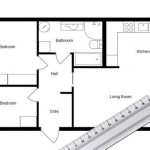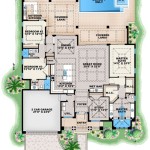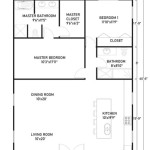Floor Plan Of A House With Measurements: A Comprehensive Guide
A floor plan is a scaled diagram of a room or building viewed from above. It is a fundamental document in architecture, interior design, and real estate, serving as a blueprint for understanding the layout and spatial relationships within a structure. Including measurements on a floor plan elevates its functionality, providing precise dimensions crucial for construction, renovation, and furnishing decisions. This article details the components of a floor plan with measurements, its significance, and how to interpret the information it presents.
The primary purpose of a floor plan with measurements is to communicate the size and arrangement of spaces within a building. It illustrates the location of walls, doors, windows, and built-in features. The inclusion of measurements allows for accurate calculations of area, volume, and material quantities, which are indispensable for project planning and execution. Floor plans act as a central resource for architects, contractors, interior designers, and homeowners, ensuring everyone involved has a clear understanding of the project’s scope and requirements.
A well-executed floor plan with measurements effectively bridges the gap between design concepts and tangible construction. It facilitates informed decision-making, reduces errors, and streamlines the building or renovation process. Without accurate measurements, projects can be prone to costly miscalculations and delays. Therefore, understanding the elements and proper interpretation of a measured floor plan is paramount for successful project outcomes.
Essential Components of a Floor Plan with Measurements
A complete floor plan with measurements typically encompasses several key elements. These elements work in conjunction to provide a comprehensive understanding of the space. Absence of any of those elements can render the floor plan difficult to interpret or incomplete for project execution.
Firstly,
Walls
are represented as solid lines, usually thicker than other lines on the plan. These lines indicate the physical boundaries of rooms and the exterior of the building. Measurements are often placed alongside the wall lines to indicate their length and thickness. Interior walls are differentiated from exterior walls by varying line thickness, denoting load-bearing versus non-load-bearing walls. The presence of fire-rated walls might also be indicated through specific hatching or notation.Secondly,
Doors and Windows
are represented by specific symbols. Doors typically swing into or out of a room, and the direction of the swing is indicated on the plan. The width of the door opening is provided as a measurement. Windows are usually represented by a series of parallel lines within the wall, and their width and height are also dimensioned. The floor plan will also specify window sill heights from the floor, usually in accompanying elevations drawings. The type of window (casement, sliding, double-hung) is not usually indicated on the floor plan itself, but is indicated on window schedules.Thirdly,
Room Labels
identify the purpose of each space within the building. These labels are usually placed centrally within the room and are accompanied by the room's dimensions and area calculations. Examples include "Living Room," "Bedroom 1," "Kitchen," and "Bathroom." The room label often includes the finished floor material, such as “Tile,” “Carpet,” or “Hardwood.”Fourthly,
Measurements
are perhaps the most critical component. They indicate the length, width, and height of various features. Measurements are typically given in feet and inches (imperial system) or meters and centimeters (metric system). Overall dimensions of the building, individual room dimensions, and the placement of fixtures are all accurately noted on the floor plan. The placement of dimensions must be systematic and clear to avoid confusion. Dimension lines, extension lines and arrowheads are all part of a clear dimensional system.Fifthly,
Fixtures and Appliances
are also represented by symbols. These include items like sinks, toilets, bathtubs, kitchen appliances (refrigerators, ovens, dishwashers), and other built-in features. Their location and size are indicated on the plan. The type of appliance or fixture, such as a specific model of refrigerator, is not usually indicated on the floor plan.Finally,
Stairs
are represented by a series of lines indicating the risers and treads of the staircase. The direction of travel (up or down) is usually indicated by an arrow. The number of risers, tread depth, and overall stair dimensions are also included. Headroom clearance above the stairs is usually verified in section drawings.Interpreting Measurements on a Floor Plan
Understanding how to interpret the measurements provided on a floor plan is crucial for accurate planning and execution. Measurements can be presented in various ways, but the core principles remain consistent.
Firstly,
Overall Dimensions
are usually indicated along the exterior walls of the building. These dimensions provide the total length and width of the structure. They are essential for determining the building's footprint and its fit within the property boundaries. The overall dimensions are normally continuous dimension lines extending all the way from one exterior wall to another. They also include thickness of walls and any exterior features, such as porches or decks.Secondly,
Interior Dimensions
specify the size of individual rooms and spaces. These dimensions are typically given between walls, from the interior face of one wall to the interior face of the opposite wall. They may also indicate distances between features, such as a wall and a window. Understanding interior dimensions is crucial for furniture placement and space planning. Interior dimensions are generally broken down into smaller segments between walls and other features rather than continuous lines.Thirdly,
Thickness of Walls
is also indicated on the plan. This is important for calculating the net usable space within a room. Exterior walls are generally thicker than interior walls, reflecting their structural role. The thickness of walls is factored into the overall dimension of the building, so it’s important to note where the measurement lines start and end. For example, a room's length can be described as the distance "between studs" or "from drywall to drywall".Fourthly,
Door and Window Dimensions
specify the width and height of these openings. Door dimensions indicate the clear opening width, while window dimensions indicate the size of the window frame. These measurements are essential for selecting appropriate doors and windows for the building. Door and window schedules usually contain more specific information about the type of door or window that is required.Fifthly,
Fixture Placement
dimensions indicate the distance of fixtures from walls or other features. This is essential for ensuring proper clearances and accessibility. For example, the distance between a toilet and a wall or the height of a countertop from the floor. The dimension is key to understanding building codes and accessibility requirements.The system of dimensioning must be consistent throughout the floor plan. Dimensions are usually aligned and placed outside the boundaries of the walls to avoid cluttering the interior space. Arrows and extension lines indicate the points between which the measurement is taken. It is important to pay attention to the unit of measurement used (feet and inches or meters and centimeters) to avoid misinterpretations. Careful examination of these elements ensures accurate understanding and utilization of the information presented on the floor plan.
The Significance of Accuracy in Floor Plan Measurements
Accuracy in floor plan measurements is paramount for a successful building or renovation project. Even small discrepancies can lead to significant problems during construction or installation.
Firstly,
Material Estimation
relies heavily on accurate floor plan measurements. Incorrect dimensions can result in underestimation or overestimation of required materials, leading to wasted resources or costly delays. For example, ordering flooring, drywall, or paint requires precise area calculations based on the dimensions provided in the floor plan. If the floor plan calls out a room that is actually smaller or larger, the order will not be sufficient or will have costly waste.Secondly,
Furniture Placement and Space Planning
are dependent on accurate room dimensions. Using a floor plan with precise measurements allows homeowners and interior designers to plan the layout of furniture and other items effectively. This prevents overcrowding or the purchase of furniture that is too large for the space. Prior to ordering new furniture, homeowners will often use a copy of the floor plan and mark the dimensions of the furniture to make sure it will fit into the room according to its intended layout.Thirdly,
Building Code Compliance
often requires specific dimensions and clearances to be met. Accurate floor plan measurements ensure that the building design adheres to these regulations, preventing potential code violations and associated penalties. For example, minimum room sizes, hallway widths, and accessibility requirements are all dictated by building codes, and these dimensions must be reflected accurately in the floor plan.Fourthly,
Construction Accuracy
relies heavily on the precision of the floor plan. Contractors use the plan as a guide for laying out walls, installing fixtures, and completing other construction tasks. Errors in the plan can lead to misaligned walls, incorrectly sized rooms, and other costly mistakes. The dimensions on the floor plan act as the contract document between the designer and the builder. The builder will rely on the dimensions to build in accordance with the design intent.Fifthly,
Cost Control
is intrinsically linked to accurate measurements. Precise dimensions enable accurate cost estimations for materials, labor, and other project expenses. This helps to avoid budget overruns and ensures that the project remains financially feasible. Revisions required because of errors in the measurements are costly both in construction and in design fees.Therefore, investing in professional floor plan creation with accurate measurements is a worthwhile investment. Whether utilizing computer-aided design (CAD) software or employing traditional drafting techniques, meticulous attention to detail is crucial. Verification of measurements through on-site surveys is also recommended to ensure accuracy, particularly in renovation projects involving existing structures. The overall success of the project hinges on the reliability and precision of the floor plan measurements.

12 Examples Of Floor Plans With Dimensions

How To Read A Floor Plan With Dimensions Houseplans Blog Com

House Plans How To Design Your Home Plan

12 Examples Of Floor Plans With Dimensions

Floor Plans With Dimensions Including Examples Cedreo

Floor Plan With Dimensions Guide To Drawings Small House Blueprints Design S

12 Examples Of Floor Plans With Dimensions

A Floorplan Of Single Family House All Dimensions In Meters Scientific Diagram

How To Read A Floor Plan With Dimensions Houseplans Blog Com

How To Read A Floor Plan And Design The Perfect Home For You








